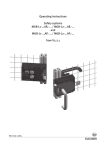Download Operating Instructions Non-Contact Safety Switch CES
Transcript
Operating Instructions Non-Contact Safety Switch CES-AR-C01-AH-SA (Unicode) More than safety. Operating Instructions Safety Switch CES-AR-C01-AH-SA Contents Correct use Possible combinations for CES components 3 4 Exclusion of liability and warranty 5 General safety instructions 5 Function6 Changing the approach direction 7 Mounting8 Electrical connection Safety in case of faults Fuse protection for power supply Requirements for connection cables Maximum cable lengths Connector assignment of safety switch CES-AR Connection of a single CES-AR-C Connection of several CES-AR-C in a switch chain Notes on operation with safe control systems 9 10 10 11 11 13 14 16 18 Setup20 LED indicators 20 Teach-in function for actuator 20 Functional check 22 System status table 23 Technical data Technical data for safety switch CES-AR-C01-AH-SA Technical data for actuator CES-A-BBA Technical data for actuator CES-A-BPA Technical data for actuator CES-A-BRN 24 24 27 29 31 Ordering information and accessories 33 Inspection and service 33 Service34 Declaration of conformity 35 2 Operating Instructions Safety Switch CES-AR-C01-AH-SA Correct use The Coded Electronic Safety switches series CES are safety devices for monitoring movable safety guards. In combination with a separating safety guard and the machine control, this safety component prevents dangerous machine movements from occurring while the safety guard is open. A stop command is triggered if the safety guard is opened during the dangerous machine function. Before safety switches are used, a risk assessment must be performed on the machine, e.g., in accordance with: ÌÌEN ISO 13849-1, Safety of machinery. Safety related parts of control systems. General principles for design ÌÌEN ISO 12100, Safety of machinery – General principles for design – Risk assessment and risk reduction ÌÌIEC 62061, Safety of machinery. Functional safety of safety-related electrical, electronic and programmable electronic control systems. Correct use includes compliance with the relevant requirements for installation and operation, for example ÌÌEN ISO 13849-1, Safety of machinery. Safety related parts of control systems. General principles for design ÌÌEN 1088, Safety of machinery. Interlocking devices associated with guards. Principles for design and selection ÌÌEN 60204-1, Safety of machinery. Electrical equipment of machines. General requirements ÌÌEN 60947-5-3, Specification for low-voltage switchgear and controlgear. Con- trol circuit devices and switching elements. Requirements for proximity devices with defined behavior under fault conditions The safety switch must be used only in conjunction with the designated CES actuators from EUCHNER. On the use of different actuators, EUCHNER provides no warranty for safe function. Several devices are only allowed to be connected in series using devices intended for series connection with the CES-AR. Check the operating instructions for the related device. A combination of other CES devices or devices from other manufacturers is not allowed. A maximum of 20 safety switches are allowed to be operated in a switch chain. Important! ÌÌThe user is responsible for the integration of the device into a safe overall system. For this purpose, the overall system must be validated, e.g. in accordance with EN ISO 13849-2. ÌÌCorrect use requires observing the permissible operating parameters (see Technical data). ÌÌIf a product data sheet is included with the product, the information on the data sheet applies in case of discrepancies with the operating instructions. ÌÌIn the estimation of the PL for the overall system, a maximum value of 100 years can be assumed for the MTTFd according to the limit value in EN ISO 13849-1:2008, section 4.5.2. This corresponds to a minimum value for the PFHd of 2.47x10-8/h. ÌÌWhen up to 11 devices are connected in series, these limit values can be assumed for the entire switch chain as a subsystem. As a subsystem, this switch chain achieves PL e. 3 Operating Instructions Safety Switch CES-AR-C01-AH-SA Important! ÌÌIn the case of series connection of more than 11 devices, the PFHd can be calculated according to one of the stated methods in EN ISO 13849-1:2008, section 4.5.1. ÌÌIf the simplified method according to section 6.3 of EN ISO 13849:2008-12 is used for validation, the Performance Level (PL) might be reduced when more than 11 devices are connected in series. ÌÌIt is only allowed to use components that are permissible in accordance with the table below. Possible combinations for CES components 100251 CES-A-BRN 098775 CES-A-BPA 071840 Safety switches CES-A-BBA Actuator CES-AR-C01-AH-SA 098941 Key to symbols Combination possible Note: Devices with version number V 1.1.2 or higher can be operated on an AR evaluation unit. Please refer to the operating instructions for the relevant AR evaluation unit for more information. 4 Operating Instructions Safety Switch CES-AR-C01-AH-SA Exclusion of liability and warranty In case of failure to comply with the conditions for correct use stated above, or if the safety instructions are not followed, or if any servicing is not performed as required, liability will be excluded and the warranty void. General safety instructions Safety switches fulfill personal protection functions. Incorrect installation or tampering can lead to fatal injuries to personnel. Check the safe function of the safety guard particularly ÌÌafter any setup work ÌÌafter the replacement of a CES component ÌÌafter an extended period without use ÌÌafter every fault Independent of these checks, the safe function of the safety guard should be checked at suitable intervals as part of the maintenance schedule. Warning! Danger of fatal injury in the event of incorrect connection or incorrect use. ÌÌSafety switches must not be bypassed (bridging of contacts), turned away, removed or otherwise rendered ineffective. On this topic pay attention in particular to the measures for reducing the possibility of bypassing from EN 1088:1995+A2:2008, section 5.7. The device is only allowed to be installed and placed in operation by authorized personnel ÌÌwho are familiar with the correct handling of safety components ÌÌwho are familiar with the applicable EMC regulations ÌÌwho are familiar with the applicable regulations on health and safety and accident prevention ÌÌwho have read and understood the operating instructions. Caution! Risk of damage to equipment as a result of incorrect installation. Safety switches must not be used as a mechanical end stop. ÌÌFit an additional end stop for the movable part of the safety guard. Important! Prior to use, read the operating instructions and keep these in a safe place. Ensure that the operating instructions are always available during mounting, setup and servicing work. EUCHNER cannot provide any warranty in relation to the readability of the CD for the storage period required. For this reason you should archive a printed copy of the operating instructions. You can download the operating instructions from www.EUCHNER.de. 5 Operating Instructions Safety Switch CES-AR-C01-AH-SA Function The device complies with the following safety requirements: ÌÌCategory 4, PLe according to EN ISO 13849-1 ÌÌRedundant design of the circuit in the unit with self-monitoring ÌÌThis means that the safety system still functions even if an internal component fails ÌÌThe switch state of the semiconductor outputs is continuously monitored internally ÌÌShort circuit detection at the safety outputs by pulse signals The following switch-on condition applies to safety outputs OA and OB (see also System status table and the section Typical system times): ÌÌSafety guard closed ÌÌBoth safety outputs (IA and IB) must be on The system consists of the following components: coded actuator (transponder) and switch. Every EUCHNER actuator supplied has an electronic coding (unique coding) that is read by the read head. Only if a correct coding is detected does the system accept the actuator. The code in an actuator cannot be reprogrammed. The actuator must be assigned to the safety switch by a teach-in process so that it is detected by the system. This unambiguous assignment ensures a particularly high level of protection against tampering. The safety switch is fastened to the fixed part of the safety guard. The actuator attached to the movable part of the safety guard is moved towards the read head fitted in the safety switch by closing the door. When the switch-on distance is reached, power is supplied to the actuator by the read head by induction and data can be transferred. If a permissible code is detected, the safety outputs are released. Due to the combination of dynamic polling of the actuator and the redundant, diverse design of the safety electronics with the two feedback safety outputs, the safety switch will enter the safe state with every detectable fault. When the safety guard is opened, the safety outputs switch off the safety circuit and the monitoring output (OUT) is switched off. The state of the safety outputs is monitored internally by two microprocessors. If faults are detected, the safety circuit is switched off and the DIA LED illuminates. In case of devices with a DIA monitoring output, the output is switched on. The safety switch has a redundant circuit design with self-monitoring. This means that the safety system is still effective even if a component fails. The system is designed so that failures will not result in the loss of the safety function. The occurrence of failures is detected by cyclic self-monitoring at the latest on the next demand to close the safety contacts (e.g. on starting). If the safety door with the actuator should settle over time, the actuator can drift out of the read head operating distance. The device recognizes this and indicates that the actuator is in the limit range (function available for V 1.1.2 and higher). This allows the safety door to be readjusted in time. 6 Operating Instructions Safety Switch CES-AR-C01-AH-SA Changing the approach direction Caution! Risk of damage to equipment as a result of trapped cables. ÌÌMake sure that the cables are not trapped or torn off when the approach direction is changed. The active face of the read head can be adjusted in 5 directions. It is marked by the red face. The plug connector can be realigned in 45° steps to change the direction of the cable outlet (when using elbow connectors). 1. Remove the top part of the mounting base and push the bottom part of the mounting base off the read head. 2. Unscrew the screws on the fastening bracket. 3. Undo the read head from the fastening bracket and tilt the read head forward by 90°. ¨¨ The active face is now pointing downward. 4. Hold the fastening bracket tight and turn the read head by 180°. 5. Re-tighten the screws for the read head on the fastening bracket. Tightening torque 0.6 Nm. 6. Turn the read head in 90° steps until the desired approach direction is reached. Change the alignment of the plug connector if necessary. 7. Push the read head onto the bottom part of the mounting base and reassemble the mounting base. 7 Operating Instructions Safety Switch CES-AR-C01-AH-SA Mounting Important! ÌÌFrom the assured switch-off distance Sar, the safety outputs are safely shut down. ÌÌWhen mounting several safety switches, observe the stipulated minimum distance to avoid mutual interference. min. 80mm ÌÌIf the actuator is installed flush, the switching distance changes as a function of the installation depth and the safety guard material. Flush mounting Surface mounting Actuator Actuator Operating distance Operating distance Note the following points: ÌÌActuator and safety switch must be easily accessible for inspection and replacement. ÌÌThe switching operation must only be triggered by the specific actuator designated for this purpose. ÌÌActuator and safety switch must be fitted so that ÌÌthe front faces are at the minimum switch-on distance 0.8 x Sao or closer when the safety guard is closed (see section Operating distances). To avoid entering the area of possible side lobes, a minimum distance is to be maintained in case of a side approach direction. See section Typical operating distance for the related actuator. ÌÌwhen the safety guard is open up to the distance Sar (assured switch-off distance), a hazard is excluded. ÌÌthe actuator is positively mounted on the safety guard, e.g. by using the safety screws included. ÌÌthey cannot be removed or tampered with using simple means. ÌÌPay attention to the maximum tightening torque for the read head or safety switch and actuator mountings of 1 Nm. For read heads/actuators made of PE-HD, the maximum tightening torque is only 0.5 Nm. 8 Operating Instructions Safety Switch CES-AR-C01-AH-SA Electrical connection The following connection options are available: ÌÌSeparate operation ÌÌSeries connection with Y-distributors from EUCHNER (only with M12 plug connector) ÌÌSeries connection, e.g. with wiring in the control cabinet. ÌÌOperation on an AR evaluation unit Warning! In the event of a fault: Loss of the safety function due to incorrect connection. ÌÌTo ensure safety, both safety outputs (OA and OB) must always be evaluated. ÌÌThe monitoring output OUT or DIA must not be used as a safety output. ÌÌLay the connection cables with protection to prevent the risk of short circuits. Caution! Risk of damage to equipment or malfunctions as a result of incorrect connection. ÌÌDo not use a control system with pulsing or switch off the pulsing function in your control system. The device generates its own clock signal on the output lines OA/OB. A downstream control system must tolerate these pulses, which may have a length of up to 1 ms. The pulses are also output when the safety outputs are switched off. Depending on the inertia of the connected device (control system, relay, etc.), this can lead to short switching processes. ÌÌThe inputs on an evaluation unit connected must be positive-switching, as the two outputs on the safety switch deliver a level of +24 V in the switched-on state. ÌÌAll the electrical connections must either be isolated from the mains supply by a safety transformer according to IEC 61558-2-6 with limited output voltage in the event of a fault, or by other equivalent isolation measures (PELV). ÌÌFor use and operation as per the requirements, a power supply with the feature "for use in class 2 circuits" must be used. The same requirement applies to the safety outputs. Alternative solutions must comply with the following requirements: a) Electrically isolated power supply unit with a max. open-circuit voltage of 30 V/DC and a limited current of max. 8 A. b) Electrically isolated power supply unit in combination with fuse as per UL248. This fuse should be designed for max. 3.3 A and should be integrated into the 30 V/DC voltage section. ÌÌFor use and applications as per the requirements of , a connection cable listed under the UL category code CYJV2 or CYJV must be used. The connection cables from EUCHNER meet these requirements. The same requirement applies to the safety outputs. ÌÌAll electrical outputs must have an adequate protective circuit for inductive loads. The outputs must be protected with a free-wheeling diode for this purpose. RC interference suppression units must not be used. ÌÌPower devices which are a powerful source of interference must be installed in a separate location away from the input and output circuits for signal processing. The cable routing for safety circuits should be as far away as possible from the cables of the power circuits. 9 Operating Instructions Safety Switch CES-AR-C01-AH-SA Caution! ÌÌIn order to avoid EMC interference, the physical environmental and operating conditions at the installation site of the device must comply with the requirements according to the standard EN 60204-1:2006, section 4.4.2 (EMC). ÌÌPlease pay attention to any interference fields in case of devices such as frequency converters or induction heating systems. Observe the EMC instructions in the manuals from the respective manufacturer. Important! If the device does not appear to function when operating voltage is applied (e.g. green STATE LED does not flash), the safety switch must be returned unopened to the manufacturer. Safety in case of faults ÌÌThe operating voltage UB is reverse polarity protected. ÌÌThe contacts OA/OB are short circuit proof. ÌÌA short circuit between OA and OB is detected by the switch. ÌÌA short circuit in the cable can be excluded by laying the cable with protection. Fuse protection for power supply The power supply must be provided with fuse protection depending on the number of switches and current required for the outputs. The following rules apply: Max. current consumption of an individual switch Imax Imax = IUB + IOUT + IOA+OB IUB = Switch operating current (50 mA) IOUT = Monitoring output load current (max. 200 mA) IOA+OB = Load current of safety outputs OA + OB (2 x max. 400 mA) Max. current consumption of a switch chain Σ Imax Σ Imax= IOA+OB + n x (IUB + IOUT) n = Number of connected switches 10 Operating Instructions Safety Switch CES-AR-C01-AH-SA Requirements for connection cables Caution! Risk of damage to equipment or malfunctions as a result of incorrect connection cables. ÌÌUse connection components and connection cables from EUCHNER ÌÌOn the usage of other connection components, the requirements in the following table apply. EUCHNER provides no warranty for safe function in case of failure to comply with these requirements. Observe the following requirements with respect to the connection cables: Parameter Value Unit Conductor cross-section 0.34 mm² R max. 60 W/km C max. 120 nF/km 0.65 mH/km L max. Recommended cable type LIYY 8x or 5x 0.34 mm² Maximum cable lengths Switch chains are permitted up to a maximum overall cable length of 200 m taking into account the voltage drop as a result of the cable resistance (see table below with example data and case example). lmax =200 m l2 l1 ln un = 24 V -20% umin = 24 V -10% iout SPS PLC 5 x 0,34 mm2 CES-AR # n CES-AR # n-1 CES-AR # 1 n Iout (mA) l1 (m) Max. number of switches Possible output current per channel OA/OB Max. cable length from the last switch to the control system 10 150 25 100 50 80 100 50 5 6 10 11 200 25 10 120 25 90 50 70 100 50 200 25 10 70 25 60 50 50 100 40 200 25 Operating Instructions Safety Switch CES-AR-C01-AH-SA Determining cable lengths using the example table Example: 6 switches are to be used in series. Cabling with a length of 40 m is routed from a safety relay in the control cabinet to the last switch (#6). Cables with a length of 20 m each are connected between the individual CES-AR safety switches. lmax = 140 m l2 = 5 x 20 m l1 = 40 m ln = 20 m un = min. 19,2 V Sicherheitsrelais iout = min. 75 mA Safety Relay CES-AR # 6 CES-AR # 5 CES-AR # 4 CES-AR # 3 CES-AR # 2 CES-AR # 1 Figure 1: Circuit example with six CES-AR A safety relay is connected downstream which consumes 75 mA at each of the two safety inputs. This operates over the whole temperature range with a voltage of 19.2 V (corresponds to 24 V -20%). All the relevant values can now be determined using the example table: 1. Select the corresponding section in the column n (max. number of switches). Here: 6 switches. 2. In column Iout (possible output current per channel OA/OB), find a current greater than or equal to 75 mA. Here: 100 mA. ¨¨ It is then possible to determine the maximum cable length from the last switch (#6) to the control system from column l1. Here: a length of 50 m is permitted. Result: The desired cable length l1 of 40 m is below the permitted value from the table. The overall length of the switch chain lmax of 140 m is less than the maximum value of 200 m. ¨¨ The planned application is therefore functional in this form. 12 Operating Instructions Safety Switch CES-AR-C01-AH-SA Connector assignment of safety switch CES-AR RST UB 0V IA IB OA OB OUT 8 2 7 6 7 8 6 1 5 4 1 3 4 5 Coding lug 2 3 View on the connection side of the safety switch Figure 2: Connector assignment of safety switch CES-AR Pin Designation Description 1 IB Enable input for channel 2 Wire color white 2 UB Power supply, DC 24 V brown 3 OA Safety output, channel 1 green 4 OB Safety output, channel 2 yellow 5 OUT/DIA Monitoring output gray 6 IA Enable input for channel 1 pink 7 0V Ground, DC 0 V blue 8 RST Reset input red 13 Operating Instructions Safety Switch CES-AR-C01-AH-SA Connection of a single CES-AR-C If a single CES-AR-C is used, connect the switch as shown in Figure 3. The OUT output can also be connected here to a control system as a monitoring output. The switch can be reset via the RST input. To do this, a voltage of 24 V is applied to the RST input for at least 3 seconds. The RST input must be connected to 0 V if it is not used. Important! The subsystem CES-AR complies with PL e in accordance with EN 13849-1. To integrate the subsystem in a category 3 or 4 structure, it is necessary to monitor the downstream load (the feedback loop must be monitored). These examples show only an excerpt that is relevant for connection of the CES system. The example illustrated here does not show complete system planning. The user is responsible for safe integration in the overall system. RST A1 -K1 13 A2 8 0V 7 IA 6 OUT 5 OB 4 OA 3 UB 2 1 IB DC 24 V M12 plug-connector (8-pin) CES-AR-C #1 14 -K2 A1 13 A2 14 -M1 GND Figure 3: Connection example for a single CES-AR-C 14 M Operating Instructions Safety Switch CES-AR-C01-AH-SA Warning! In the event of a fault: Loss of the safety function due to incorrect connection. ÌÌTo ensure safety, both safety outputs (OA and OB) must always be evaluated. Single-channel use of the safety outputs leads to a loss of the category in accordance with EN ISO 13849-1. 0V RST 6 8 IA 5 7 OB OUT 4 OA 3 IB UB 1 2 DC 24 V A1 -K1 13 A2 M12 plug-connector (8-pin) CES-AR #1 14 -K2 A1 13 A2 14 -M1 GND Figure 4: Example of incorrect connection. 15 M -M2 M Operating Instructions Safety Switch CES-AR-C01-AH-SA Connection of several CES-AR-C in a switch chain Important! ÌÌAn AR switch chain may contain a maximum of 20 safety switches. ÌÌIn the estimation of the PL for the overall system, a maximum value of 100 years can be assumed for the MTTFd according to the limit value in EN ISO 13849-1:2008, section 4.5.2. This corresponds to a minimum value for the PFHd of 2.47x10-8/h. ÌÌWhen up to 11 devices are connected in series, these limit values can be assumed for the entire switch chain as a subsystem. As a subsystem, this switch chain achieves PL e. ÌÌIn the case of series connection of more than 11 devices, the PFHd can be calculated according to one of the stated methods in EN ISO 13849-1:2008, section 4.5.1. ÌÌIf the simplified method according to section 6.3 of EN ISO 13849:2008-12 is used for validation, the Performance Level (PL) might be reduced when more than 11 devices are connected in series. The series connection is shown here based on the example of the version with plug connectors M12. The switches are connected one behind the other with the aid of pre-assembled connection cables and Y-distributors. If a safety door is opened or if a fault occurs on one of the switches, the system shuts down the machine. A higher level control system cannot, however, detect which safety door is open or on which switch a fault has occurred with this connection technology. A special AR evaluation unit is required for this purpose (see section Information on operation on an AR evaluation unit). The series connection can also be realized via additional terminals in a control cabinet. The safety outputs are permanently assigned to the respective safety inputs of the downstream switch. OA must be connected to IA and OB to IB. If the connections are interchanged (e.g. OA to IB), the unit will switch to fault state). Always use input RST in series connections. All switches in a chain can be reset at the same time with this reset input. To do this, a voltage of 24 V must be applied to the RST input for at least 3 seconds. If input RST is not used in your application, it should be connected to 0 V. Note the following on this aspect: ÌÌA common signal must be used for all switches in the chain. This can be a changeover switch or the output of a control system. A button is not suitable because Reset must always be connected to GND during operation (see switch S1 in Figure 5). ÌÌReset must always be performed simultaneously for all switches of the chain. Information on operation on an AR evaluation unit Devices with version number V 1.1.2 or higher can be operated on an AR evaluation unit. Please refer to the operating instructions for the relevant AR evaluation unit for more information. 16 Terminating plug 17 IB 6 IA Safety Inputs 1 8 Y-distributor 5 RST 2 UB 7 0V OA 4 OB CES Safety Outputs OUT 3 5 OUT 3 OA IB 6 IA Safety Inputs 1 8 RST 2 UB 7 0V Y-distributor OB CES Safety Outputs 4 IB 1 6 8 2 7 5 3 4 IA 4 4 OB 4 IB 0V 2 2 OA 3 3 0V 2 UB 1 IA RST 5 1 5 UB Read Head 1 Read Head RST Y-distributor IB IA RST UB 0V OUT OA OB UB Terminating plug IB 6 IA Safety Inputs 1 8 RST 2 UB 7 0V Y-distributor 5 3 OA 4 OB CES Safety Outputs OUT 11 -S1 14 12 Eval Unit 0V 24V Operating Instructions Safety Switch CES-AR-C01-AH-SA Figure 5: Connection example for series connection with reset and changeover switch. Read Head Operating Instructions Safety Switch CES-AR-C01-AH-SA Notes on operation with safe control systems Please observe the following requirements for connection to safe control systems: ÌÌUse a common power supply for the control system and the connected safety switches. ÌÌA clocked power supply must not be used for UB. Tap the supply voltage directly from the power supply unit. If the supply voltage is connected to a terminal of a safe control system, this output must provide sufficient electrical current. ÌÌAlways connect inputs IA and IB directly to a power supply unit or to outputs OA and OB of another EUCHNER AR device (series connection). Clocked signals must not be present at inputs IA and IB. ÌÌOutputs OA and OB can be connected to the safe inputs of a control system. Prerequisite: The input must be suitable for clocked safety signals (OSSD signals, e.g. from light curtains). The control system must tolerate clock pulses on the input signals. This normally can be set up by parameter assignment in the control system. Observe the notes of the control system manufacturer. For the pulse duration of your safety switch, please refer to the section Typical system times on page 25. A detailed example of connection and setting the parameters of the control system is available for many devices at www.euchner.de, in the area Download Applications CES. The features of the respective device are dealt with there in greater detail. 18 Terminating plug 19 IB 6 IA 8 Safety Inputs 1 RST 2 UB 7 0V Y-distributor 3 OA 4 OB Safety Output OUT CES 5 IB 6 IA 8 RST Safety Inputs 1 2 UB 7 0V Y-distributor 5 3 OA 4 OB CES Safety Output OUT 1 IA RST 6 8 2 Safety Inputs IB UB 7 0V Y-distributor 5 OA OB LED1 UCM J 0V(UCM) CET 3 4 X2:3 X2:4 X2:5 X2:1 Safety Output OUT -X1 ET200 4 F-DO DO..M DO..P Digital Output DO -X1 4/8 F-DI DI4 DI0 DC24V 3 M PWR Supply of the control 2 0V 24V Operating Instructions Safety Switch CES-AR-C01-AH-SA Figure 6: Connection example for mixed series connection (2 x CES and 1 x CET) on ET200 Read Head Read Head Operating Instructions Safety Switch CES-AR-C01-AH-SA Setup LED indicators LED STATE DIA Color State Significance illuminated Normal operation flashing - Teach-in operation or Power Up - Actuator in limit range (V. 1.1.2 or higher) (refer to the status table for further signal functions) illuminated - Internal electronics fault - Fault at the inputs/outputs green red Teach-in function for actuator The actuator must be allocated to the safety switch using a teach-in function before the system forms a functional unit. During a teach-in operation, the safety outputs and the monitoring output OUT are switched off, i.e. the system is in the safe state. Important! ÌÌThe safety switch disables the code of the previous actuator if teach-in is carried out for a new actuator. Teach-in is not possible again immediately for this actuator if a new teach-in operation is carried out. The disabled code is released again in the safety switch only after a third code has been taught. ÌÌThe safety switch can only be operated with the last actuator taught. ÌÌIf the switch detects the actuator that was most recently taught when in teach-in standby state, this state is ended immediately and the switch changes to normal state. ÌÌThe actuator being taught is not activated if it is within the operating distance for less than 60 s. Actuator teach-in 1. Apply operating voltage to the safety switch. ¨¨ The green LED flashes quickly (approx. 10 Hz) A self-test is performed during this time (approx. 8 s). After this, the LED flashes cyclically three times and signals that it is in standby state for teachin. Standby state for teach-in remains active for approx. 3 minutes. 2. Move new actuator to the read head (observe distance < Sao). ¨¨ Teach-in operation starts, green LED flashes (approx. 1 Hz). During teach-in, the safety switch checks whether the actuator is a disabled actuator. If this is not the case, the teach-in operation is completed after approx. 60 seconds, the green LED goes out. The new code has been saved, the old code disabled. 3. To activate the new actuator code from the teach-in operation in the safety switch, the operating voltage to the safety switch must then be switched off for min. 3 seconds. 20 Operating Instructions Safety Switch CES-AR-C01-AH-SA Teach-in function for series connection It is recommended not to teach in the actuators in the series connection but to teach them in one by one instead. Teach-in in a series connection works analogously to individual operation in principle. All switches in the chain can be taught in at the same time. The prerequisite is that the switch chain functions without problems and the following steps are followed. Further steps might have to be observed for mixed switch chains (e.g. for chains with CES and safety switches with guard locking). Observe the operating instructions for the other devices in the chain for this purpose. Proceed as follows: 1. Install the switches and actuators and connect them completely (see Figure 5 or Figure 6, for example) 2. Close all safety doors in the chain. 3. Switch on the power supply. ¨¨ The green LED STATE flashes at approx. 1 Hz on the safety switches and the associated actuators are taught in. This happens for approx. 1 minute. Do not switch off during this time and do not actuate reset. The teach-in operation has ended when all LEDs on the safety switches are off. 4. Actuate the reset for at least 3 s (24 V on RST). ¨¨ The system restarts and then functions in normal operation. Replacing and teaching-in device Work on the wiring (e.g. during device replacement) should generally be performed in a de-energized state. On certain systems, it is nevertheless necessary to perform this work and subsequent teach-in during ongoing operation. Input RST must be connected as shown in Figure 5 to permit this. Proceed as follows: 1. Open the safety door on which the switch or actuator is to be replaced. 2. Install the new switch or actuator and connect it completely. 3. Close all safety doors in the chain. 4. Actuate the reset for at least 3 s (24 V on RST). ¨¨ On the safety switch that is positioned at a new actuator, the green LED flashes at approx. 1 Hz and the actuator is taught-in. This takes approx. 1 minute – do not switch off during this time and do not actuate reset. The teach-in operation has ended when all LEDs on the device are off. 5. Actuate the reset for at least 3 s (24 V on RST). ¨¨ The system restarts and then continues to function in normal operation. 21 Operating Instructions Safety Switch CES-AR-C01-AH-SA Functional check After installation and any fault, the safety function must be fully checked. Proceed as follows: Warning! Danger of fatal injury as a result of faults in installation and functional check. ÌÌBefore carrying out the functional check, make sure that there are no persons in the danger area. ÌÌObserve the valid accident prevention regulations. 1. Switch on operating voltage. ÌÌThe safety switch carries out a self-test. The green LED STATE flashes for 8 s with 10 Hz. The STATE LED then flashes at regular intervals. 2. Close all safety guards. ÌÌThe machine must not start automatically. ÌÌThe green STATE LED illuminates continuously. 3. Enable operation in the control system. 4. Open the safety guard. ÌÌThe machine must switch off and it must not be possible to start it as long as the safety guard is open. ÌÌThe green LED STATE flashes at regular intervals. Repeat steps 2-4 for each safety guard. 22 Operating Instructions Safety Switch CES-AR-C01-AH-SA System status table X off closed on closed on flashes quickly 2 Hz Normal operation, door closed, actuator in limit range Re-adjust door (V. 1.1.2 or higher) closed off 1 x inverse Normal operation, door closed, preceding device in the switch chain signals "door open" (only with series connection) open off 1x Normal operation, door open open off 3x Door open, unit is ready for teach-in for another actuator (only short time after power-up) closed off 1 Hz X off X off 2x Input fault (e.g. missing test pulses, illogical switch state from previous switch in the switch chain) X off 4x Output error (e.g. short circuits, loss of switching ability) X off 5x Internal fault (e.g. component faulty, data error) X off STATE (green) Safety outputs OA and OB Self-test Actuator/door position 10 Hz (8 s) Setup Fault display Self-test after power up Normal operation, door closed Normal operation Teach-in standby State DIA (red) Operating mode LED indicator, output Teach-in operation Positive acknowledgment after completion of teach-in operation X X Internal fault with door fault LED not illuminated LED illuminated 10 Hz (8 s) Key to symbols 3x X LED flashes for 8 seconds at 10 Hz LED flashes three times, and this is then repeated Any state After the cause has been remedied, faults can generally be reset by opening and closing the door. If the fault is still displayed afterward, use the reset function or briefly interrupt the power supply. Please contact the manufacturer if the fault could not be reset after restarting. Important! If you do not find the displayed device status in the System status table, this indicates an internal device fault. In this case, you should contact the manufacturer. 23 Operating Instructions Safety Switch CES-AR-C01-AH-SA Technical data Note: If a product data sheet is included with the product, the information on the data sheet applies in case of discrepancies with the operating instructions. Technical data for safety switch CES-AR-C01-AH-SA Parameter Value min. Housing material typ. Unit max. PBT V0 GF30 Dimensions According to EN 60947-5-2 Weight 0.4 kg Ambient temperature at UB = DC 24 V - 20 - + 55 Storage temperature - 25 - + 70 Degree of protection °C IP67 Safety class III Degree of contamination 3 Installation position Any Connection M12 plug connector, 8-pin Operating voltage UB (reverse polarity protected, regulated, residual ripple < 5%) For the approval according to the following applies 24 ± 15% (PELV) V DC Operation only with UL Class 2 power supply, or equivalent measures Current consumption 50 mA DC 24 V, class 2 Switching load according to External fuse (operating voltage) Safety outputs OA/OB 0.25 - 8 A Semiconductor outputs, p-switching, short circuit-proof - Output voltage U(OA)/U(OB) 1) HIGH U(OA) HIGH U(OB) LOW U(OA)/U(OB) UB-1.5 UB - 400 0 Switching current per safety output Utilization category according to EN IEC 60947‑5‑2 - 1 V DC 1 mA DC-13 24 V 400 mA Caution: outputs must be protected with a free-wheeling diode in case of inductive loads. ≤ 0.25 Off-state current Ir mA p-switching, short circuit-proof Monitoring output OUT 1) 0.8 x UB - UB V DC - Max. load - - 200 mA Rated insulation voltage Ui - - 300 2) V Rated impulse withstand voltage Uimp - - 1.5 kV 1 Hz - Output voltage Resilience to vibration In acc. with EN IEC 60947-5-2 Switching frequency - Repeat accuracy R ≤ 10 EMC protection requirements % In accordance with EN IEC 60947-5-3 and EN IEC 61326-3-1 Reliability values acc. to EN ISO 13849‑1 Category 4 Performance Level PL e 2.1 x 10 -9 / h 3) PFHd Mission time 1) 2) 3) 20 years Values at a switching current of 50 mA without taking into account the cable length. Tested by employers’ liability insurance association up to 75 V. Applying the limit value from EN ISO 13849-1:2008, section 4.5.2 (MTTFd = max. 100 years), the employers’ liability insurance association certifies a PFHd of max. 2.47 x 10-8. 24 Operating Instructions Safety Switch CES-AR-C01-AH-SA Typical system times The specified times are maximum values for AR switch chains with 20 devices. Individual devices have shorter system times. Ready delay: After switching on, the device carries out a self-test for 8 s. The system is ready for operation only after this time. Switch-on time of safety outputs: The max. reaction time from the moment when the actuator is at the operating distance (safety door closed) to the moment when the safety outputs switch on Ton is 400 ms. Simultaneity monitoring, safety inputs IA/IB: If the safety inputs have different switching states for longer than 150 ms, the safety outputs OA/OB will be switched off. Risk time according to EN 60947-5-3: If an actuator moves outside the operating distance, the safety outputs OA and OB are deactivated after a maximum of 360 ms. Difference time: The safety outputs OA and OB switch with a slight time offset. They have the same signal state at the latest after a difference time of 10 ms. Clock pulses at the safety outputs: The device generates its own clock signal on the output lines OA/OB. A downstream control system must tolerate these pulses, which may have a length of up to 1 ms. This can usually be set up in the control systems by parameter assignment. If parameter assignment is not possible for your control system or if shorter clock pulses are required, please contact our support organization. The pulses are also output when the safety outputs are switched off. 25 Operating Instructions Safety Switch CES-AR-C01-AH-SA Dimension drawings and connector assignments Safety switch CES-AR... 34 20,5 40 40,5 Connector assignment for safety switch CES-AR (8-pin plug) and Y-distributor (8-pin socket) 13 Pin 56,5 7 Ø5,5 30 M12x1 LEDs Bridging plug 097645 4-pin, plug (figure similar) Function 1 IB 2 UB 3 OA 4 OB 5 OUT 6 IA 7 0V 8 RST 47 Y-distributor with connection cable 111696 or 112395 Y-distributor 097627 Socket 2 3 4 5 Socket 2 3 1 6 4 5 8 15,1 6 1 8 ( 45 °) M12x1 M12x1 M 12x1 Length l 41 15 45 15 max. 45 7 7 M 12x1 Ø 14,5 Order No. Length l [mm] 111696 200 112395 1,000 097627 M 12x1 Ø 14,6 A B 33 3 44 3 Plug 4 M12x1 3 Socket 1 20,5 15 Plug 4 2 1 2 5 2 5 35,1 2 3 Socket 5 5 4 4 1 1 Pin Function Pin Function 1 UB 1 UB Pin Function Pin Function 2 OA 2 IA 1 UB 1 UB 3 0V 3 0V 2 OA 2 IA 4 OB 4 IB 3 0V 3 0V 5 RST 5 RST 4 OB 4 IB 5 RST 5 RST 26 Operating Instructions Safety Switch CES-AR-C01-AH-SA Technical data for actuator CES-A-BBA Parameter Value min. Housing material Unit typ. max. Fortron, reinforced thermoplastic, fully encapsulated Dimensions Weight Ambient temperature - 25 42 x 25 x 12 mm 0.02 kg - Degree of protection acc. to EN IEC 60529 + 70 °C IP67/IP69K Installation position Active face opposite read head Power supply Inductive via read head Dimension drawing 12 32 ±0,1 27 25 CES-A-B 071840 ø8 ø4,5 42 Active face 4,6 Active face Operating Instructions Safety Switch CES-AR-C01-AH-SA Switching distances Operating distance for center offset m = 0 (only in combination with CES-A-BBA actuator) Parameter Value Unit min. typ. max. - 18 - Switch-on distance 15 - - Switching hysteresis 1) 1 3 - Assured switch-off distance sar - - 45 Assured switch-on distance sao 1) mm 1) The values apply for surface installation of the actuator. Typical operating distance (only in combination with CES-A-BBA actuator) Y 30 25 20 -30 15 10 5 5 5 10 10 15 15 20 20 25 25 30 X Z -30 For a side approach direction for the actuator and safety switch, a minimum distance of s = 4 mm must be maintained so that the operating distance of the side lobes is not entered. Figure 7: Typical operating distance 28 Operating Instructions Safety Switch CES-AR-C01-AH-SA Technical data for actuator CES-A-BPA Parameter Value min. Unit typ. Housing material max. PBT Dimensions 40 x 40 x 10 mm 0.025 kg Weight Ambient temperature - 25 - Degree of protection acc. to EN IEC 60529 + 70 IP67/IP69K Installation position Active face opposite read head Power supply Inductive via read head Dimension drawing 10 0 Ø 5,2 40 - 0,25 4 30 ±0,1 CES-A-BPA-098775 IP67 CD Active face Active face 2 safety screws M5 x 10 are supplied 29 °C Operating Instructions Safety Switch CES-AR-C01-AH-SA Switching distances Operating distance for center offset m = 0 (only in conjunction with actuator CES-A-BPA on surface mounting) Parameter Value Unit min. typ. max. - 22 1) - Switch-on distance Assured switch-on distance sao 18 - - Switching hysteresis 1 2 - Assured switch-off distance sar - - 58 mm 1) On surface mounting on aluminum; in a non-metallic environment the typical switching distance increases to 30 mm. Typical operating distance (only in conjunction with actuator CES-A-BPA on surface mounting) Y 45 40 35 30 25 20 15 10 5 51 -45 5 45 40 35 30 25 1 1 0 20 5 01 52 02 53 03 54 04 5 Z X -45 For a side approach direction for the actuator and read head, a minimum distance of s = 6 mm must be maintained so that the operating distance of the side lobes is not entered. Figure 8: Typical operating distance 30 Operating Instructions Safety Switch CES-AR-C01-AH-SA Technical data for actuator CES-A-BRN Parameter Value min. Housing material Unit typ. max. PPS Dimensions Weight Ambient temperature - 25 Degree of protection acc. to EN IEC 60529 80 x 40 x 15 mm 0.06 kg - + 70 IP67 Installation position Active face opposite read head Power supply Inductive via read head Dimension drawing 40 15 10,3 8,5 17 11 80 11 17 5,5 Active face 31 Active face °C Operating Instructions Safety Switch CES-AR-C01-AH-SA Switching distances Operating distance for center offset m = 0 (only in combination with actuator CES-A-BRN) Parameter Value Unit min. typ. max. - 27 - Switch-on distance 20 - - Switching hysteresis 1) - 3 - Assured switch-off distance sar - - 75 Assured switch-on distance sao 1) mm 1) The values apply for surface installation of the actuator on steel. Typical operating distance (only in conjunction with actuator CES-A-BRN on surface mounting on steel) Y 65 60 55 50 45 40 35 30 50 25 20 15 10 5 5 5 10 15 20 -5 25 30 35 X -10 -15 -20 -25 10 15 20 25 30 35 40 45 50 Z -30 -35 -40 -45 -50 -55 -60 -65 For a side approach direction for the actuator and read head, a minimum distance of s = 6 mm must be maintained so that the operating distance of the side lobes is not entered. Figure 9: Typical operating distance 32 Operating Instructions Safety Switch CES-AR-C01-AH-SA Ordering information and accessories Designation CES-AR-C01-AH-SA Version Order No. unicode 098941 Bridging plug M12, 4-pin, plug 097645 Y-distributor M12, 1x8-pin, 2x5-pin 097627 M12, 1x8-pin, 2x5-pin, length 200 mm 111696 M12, 1x8-pin, 2x5-pin, length 1,000 mm 112395 M12, 8-pin, 5 m 100177 M12, 8-pin, 10 m 100178 M12, 8-pin, 20 m 100179 Actuator BBA 42 mm x 25 mm 071840 Actuator BPA 40 mm x 40 mm 098775 Actuator BRN 80 mm x 40 mm 100251 Y-distributor with connecting cable Connection cable PVC 8-core, flying lead Tip! You will find further accessories, in particular for series connection, in the current Non-Contact Safety System CES catalog at www.euchner.de. Inspection and service Warning! Loss of the safety function because of damage to the system. In case of damage, the related safety component must be replaced. Only accessories or spare parts that can be ordered from EUCHNER may be replaced. Regular inspection of the following is necessary to ensure trouble-free long-term operation: ÌÌCheck the switching function (see section Functional check) ÌÌCheck the secure fastening of the devices and the connections ÌÌCheck for soiling No servicing is required; repairs to the device are only allowed to be made by the manufacturer. Note: The year of manufacture can be seen in the lower right corner of the rating plate. The current version number in the format (V X.X.X) can also be found on the device. The safety door must be re-adjusted when the device indicates that the actuator is in the limit range. 33 Operating Instructions Safety Switch CES-AR-C01-AH-SA Service If service support is required, please contact: EUCHNER GmbH + Co. KG Kohlhammerstraße 16 D-70771 Leinfelden-Echterdingen Service telephone: +49 711 7597-500 E-mail: [email protected] Internet: www.euchner.de 34 Operating Instructions Safety Switch CES-AR-C01-AH-SA Declaration of conformity 35 Operating Instructions Safety Switch CES-AR-C01-AH-SA 36 Operating Instructions Safety Switch CES-AR-C01-AH-SA 37 Euchner GmbH + Co. KG Kohlhammerstraße 16 D-70771 Leinfelden-Echterdingen [email protected] www.euchner.de Edition: 098039-16-10/13 Title: Operating Instructions Safety Switch CES-AR-C01-AH-SA (translation of the original operating instructions) Copyright: © EUCHNER GmbH + Co. KG, 10/2013 Subject to technical modifications; no responsibility is accepted for the accuracy of this information. More than safety.
























































